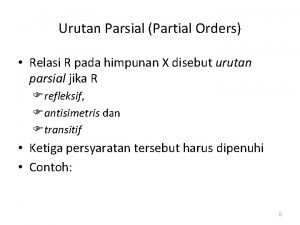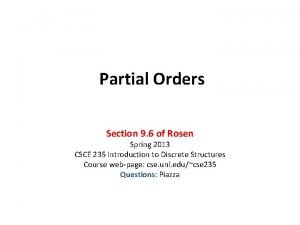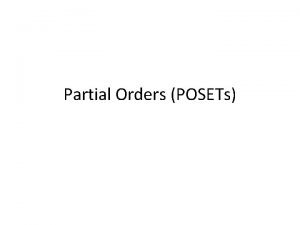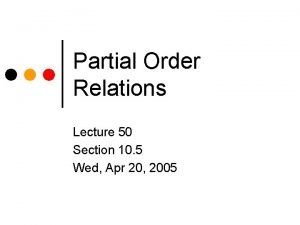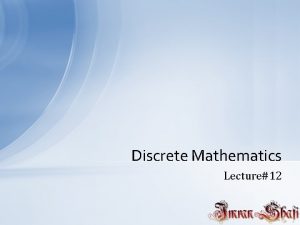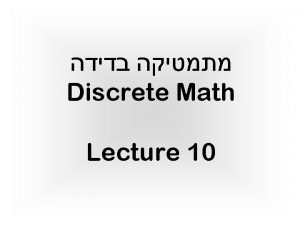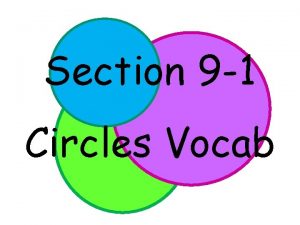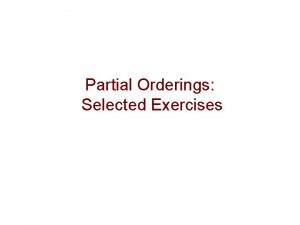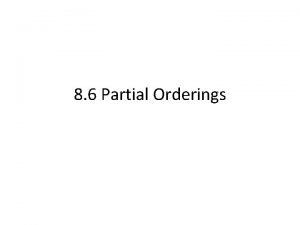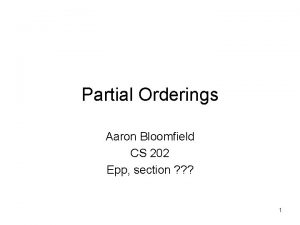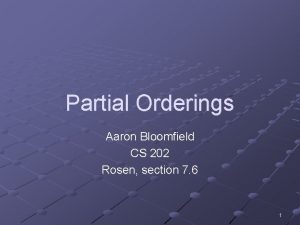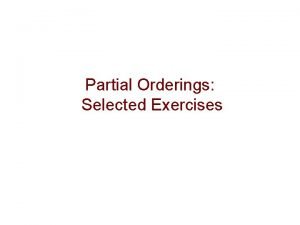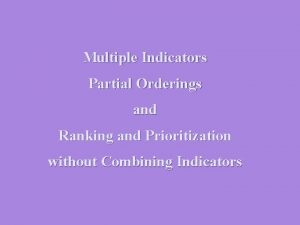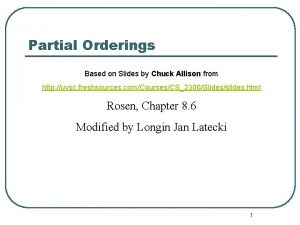Partial Orderings Section 7 6 Introduction A relation














- Slides: 14

Partial Orderings Section 7. 6

Introduction • A relation R on a set S is called a partial ordering or partial order if it is: – reflexive – antisymmetric – transitive • A set S together with a partial ordering R is called a partially ordered set, or poset, and is denoted by (S, R). CSE 2813 Discrete Structures

Example • Let R be a relation on set A. Is R a partial order? A = {1, 2, 3, 4} R = {(1, 1), (1, 2), (1, 3), (1, 4), (2, 2), (2, 3), (2, 4), (3, 3), (3, 4), (4, 4)} CSE 2813 Discrete Structures

Example • Is the “ ” relation is a partial ordering on the set of integers? – Since a a for every integer a, is reflexive – If a b and b a, then a = b. Hence is antisymmetric. – Since a b and b c implies a c, is transitive. – Therefore “ ” is a partial ordering on the set of integers and (Z, ) is a poset. CSE 2813 Discrete Structures

Comparable/Incomparable • The elements a and b of a poset (S, ≼) are called comparable if either a≼b or b≼a. • The elements a and b of a poset (S, ≼) are called incomparable if neither a≼b nor b≼a. • In the poset (Z+, |): – Are 3 and 9 comparable? – Are 5 and 7 comparable? CSE 2813 Discrete Structures

Total Order • If every two elements of a poset (S, ≼) are comparable, then S is called a totally ordered or linearly ordered set and ≼ is called a total order or linear order. • The poset (Z+, ) is totally ordered. – Why? • The poset (Z+, |) is not totally ordered. – Why? CSE 2813 Discrete Structures

Hasse Diagram • Graphical representation of a poset • Since a poset is by definition reflexive and transitive (and antisymmetric), the graphical representation for a poset can be compacted. • For example, why do we need to include loops at every vertex? Since it’s a poset, it must have loops there. CSE 2813 Discrete Structures

Constructing a Hasse Diagram • Start with the digraph of the partial order. • Remove the loops at each vertex. • Remove all edges that must be present because of the transitivity. • Arrange each edge so that all arrows point up. • Remove all arrowheads. CSE 2813 Discrete Structures

Example • Construct the Hasse diagram for ({1, 2, 3}, ) 1 2 1 3 2 CSE 2813 Discrete Structures 3 3 3 2 2 1 1

Hasse Diagram Terminology • Let (S, ≼) be a poset. • a is maximal in (S, ≼) if there is no b S such that a≼b. (top of the Hasse diagram) • a is minimal in (S, ≼) if there is no b S such that b≼a. (bottom of the Hasse diagram) • a is the greatest element of (S, ≼) if b≼a for all b S. • a is the least element of (S, ≼) if a≼b for all b S. CSE 2813 Discrete Structures

Hasse Diagram Terminology (Cont. . ) • Let A be a subset of (S, ≼). • If u S such that a≼u for all a A, then u is called an upper bound of A. • If l S such that l≼a for all a A, then l is called an lower bound of A. • If x is an upper bound of A and x≼z whenever z is an upper bound of A, then x is called the least upper bound of A. • If y is a lower bound of A and z≼y whenever z is a lower bound of A, then y is called the greatest lower bound of A. CSE 2813 Discrete Structures

Example h j g f d e b c a Maximal elements: Minimal elements: Greatest element: Least element: Upper bound of {a, b, c}: Least upper bound of {a, b, c}: Lower bound of {a, b, c}: Greatest lower bound of {a, b, c}: CSE 2813 Discrete Structures

Lattices • A partially ordered set in which every pair of elements has both a least upper bound and greatest lower bound is called a lattice. f h e c e f g b c d d b a CSE 2813 Discrete Structures a

Exercises • 1, 2, 3, 4, 5, 8, 14, 15, 17(a, b), 19, 20, 21, 26, 37 CSE 2813 Discrete Structures
 Partial order adalah
Partial order adalah Partial order relation
Partial order relation Define poset with example
Define poset with example Total order
Total order Definition of inverse relation
Definition of inverse relation Binary relation examples
Binary relation examples Half sectioning
Half sectioning Organisateur texturl
Organisateur texturl This view represents
This view represents What is a removed section view
What is a removed section view Chemical potential energy images
Chemical potential energy images Chapter 10 meiosis 1 and meiosis 2
Chapter 10 meiosis 1 and meiosis 2 Section 9 topic 1 introduction to circles
Section 9 topic 1 introduction to circles What enables motile animals to move around
What enables motile animals to move around Section 22-1 introduction to plants
Section 22-1 introduction to plants
